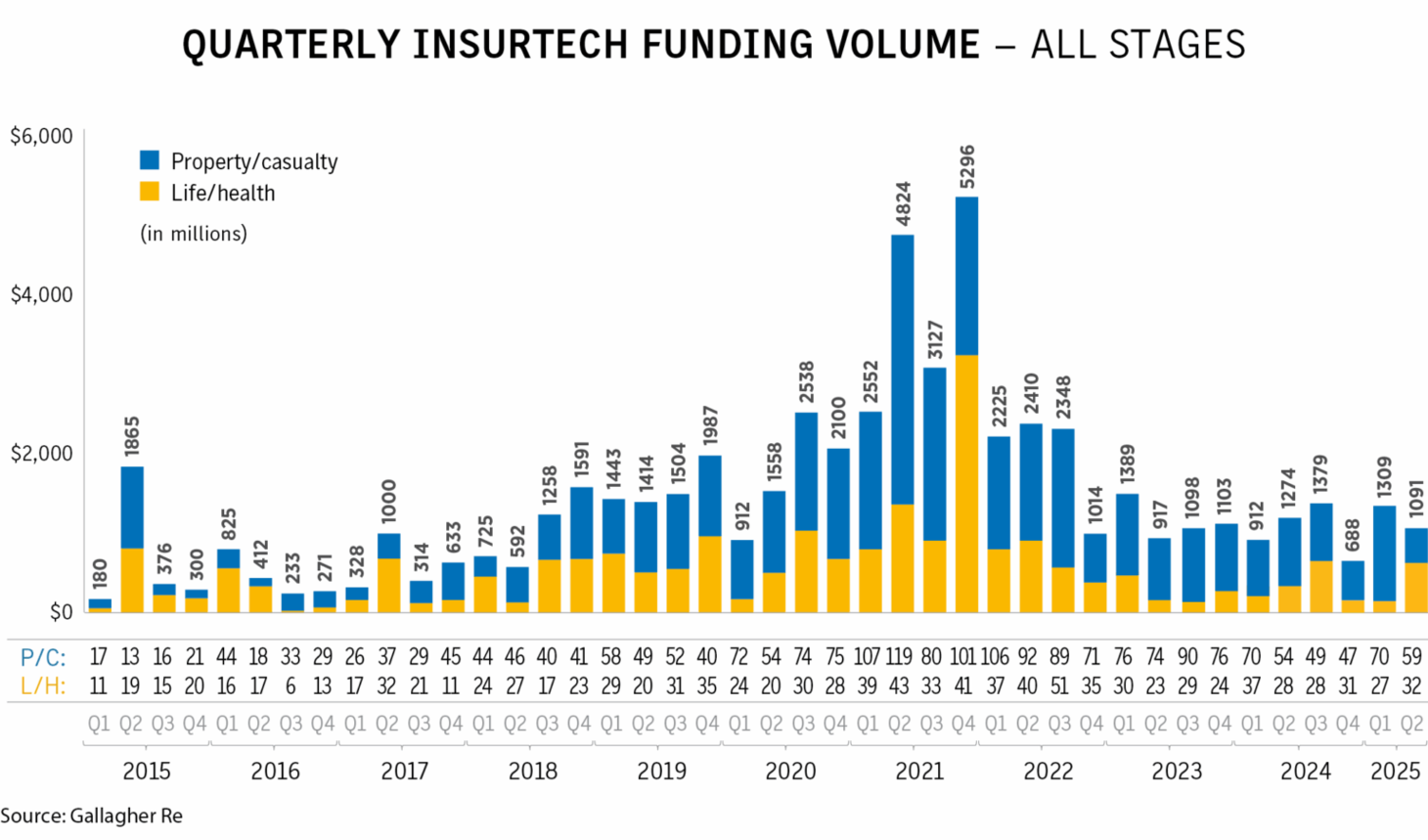Research

Top global insurtech investors
The top global insurtech investors invested in a total of 30 companies in the first quarter of 2025, with the top investor, General Catalyst, backing five insurtech companies.
Of these top 12 investors, half are located in the United States and 10 of the 12 are venture capital investor groups.
Read more about the top insurtech investors globally in the first quarter.

Q2 global insurtech funding declines 14.4% - Business Insurance
Second-quarter global insurtech funding totaled $1.09 billion, off 14.4% from second-quarter 2024, according to a report Thursday from Gallagher Re, the reinsurance business of Arthur J. Gallagher & Co.
Insurtech funding for the second quarter was also down 16.7% from first-quarter 2025 levels.
Funding for property/casualty insurtechs of $362.2 million was down 68% from the first quarter as just two of the 10 largest second-quarter deals went to property/casualty insurtechs, compared with nine of 10 in the first quarter.
Life/health funding, meanwhile, nearly tripled from first quarter to $728.5 million, the highest total since second-quarter 2022.
Second quarter continued the trend of artificial intelligence drawing funding, with 57.1% of second-quarter insurtech deals going to AI-centered companies.
Commentary/Opinion
Shock Absorption: Balancing AI Ambition with Insurance Fundamentals | Insurance Innovation Reporter
As 2026 nears, insurers must rethink entrenched methods to address rapid technological change, regulatory scrutiny, and shifting market realities.
We are now racing, not walking, into the back half of 2025. Budgeting and planning are now well underway in most organizations as they look to frame the end of this year and get ready for all that comes next. It is a year of notable contrasts. Fascinating developments in the technological world seem to be a counterpoint to a wide range of uncertainty from an economic perspective. Interest rate changes, an uncertain labor market, tariffs, and inflationary pressures are very much top of mind. Those elements run headlong into each other as insurance carriers look to both stay ahead of the curve in terms of leveraging emerging technology and, concurrently, pressing to create more operational efficiency.
It is rare in our experience to find a carrier incrementally adding expenses in order to leverage advances that come from the use of AI in its various forms, but many are looking to self-fund efforts by leveraging the capabilities to produce quick paybacks that can improve margins and reduce expense pressures that come from a highly competitive marketplace. There will be no free lunch on this.
Rob McIsaac is the President and CEO of RPM Ventures NC, LLC, an organization focused on developing deep and actionable insights that are specific to the insurance industry in North America.
The New Insurance Landscape in 2025 | Insurance Thought Leadership
AI is shifting into higher gear, transforming insurers from product providers to real-time risk managers
Artificial intelligence isn't settling for a foot in the door in 2025 – it wants to bust doors down for full commercial use, particularly with insurance companies.
A recent study by Digital Insurance shows 78% of insurance leaders saying they're expanding their technology budgets in 2025, and 36% of survey respondents said the bulk of their IT budgets are going to AI. That makes AI the highest IT priority among insurers, well ahead of top-tier issues like big data and analytics, cloud computing, and digital infrastructure.
"AI is now central to how insurers operate, affecting underwriting, claims, customer experience, and fraud detection," said Guy Gresham, a global capital markets board advisor and former director of investor relations at BNY.
Most insurers are in the speculative and development stage with AI, the DI study reports, but in specific insurance sectors like healthcare, "are already in full AI production."
So, what does the AI-led insurance innovation landscape look like in mid-2025?
Here's an inside look.
Brian O’Connell is an analyst at insuranceQuotes.com, which publishes in-depth studies, data and analysis related to auto, home, health, life and business insurance.

Five imperatives insurers must get right by 2026 - WTW
The insurance industry is at a crossroads. While technology has been reshaping the sector for years, the pace of change is now exponential, and the next 18 months will separate the innovators from the laggards.
In a recent podcast, industry experts Frank Schepers and Sina Thieme discussed the impact of technology on insurance, exploring topics such as risk modelling, data analysis, and distribution channels.
From this, five urgent priorities emerged – each one a call to action for insurers who want to thrive in a rapidly evolving landscape.
Create an incline in the playing field that AI is flattening
AI is democratizing access to advanced analytics, levelling the playing field between incumbents and challengers. But that doesn’t mean everyone wins.
In 2025, AI is no longer a differentiator – it’s a baseline. The real edge now lies in how insurers apply AI: embedding it into underwriting, claims, and customer engagement in ways that are proprietary, explainable, and scalable.
In 2025, AI is no longer a differentiator – it’s a baseline. The real edge now lies in how insurers apply AI: embedding it into underwriting, claims, and customer engagement in ways that are proprietary, explainable, and scalable.
Frank Schepers emphasized that “without the clever thinking at the back end, why collect data at all?” The key is to combine AI with deep domain expertise and unique data assets. Insurers must also navigate the ethical and regulatory implications of AI. As AI becomes more embedded in underwriting, pricing, and claims, scrutiny over how these systems make decisions is intensifying. MORE
AI in Insurance
Majesco’s AI-First Vision Redefines Core Systems Strategy
President and CPO Manish Shah explains how Majesco’s intelligent core, embedded AI, and acquisitions prepare carriers for a rapidly changing decade.
When Manish Shah, President and Chief Product Officer of Majesco, reflects on the company’s transformation over the past several years, he speaks less about technology in isolation and more about the mindset required to make it work. “Moving to the cloud requires a mindset shift,” he says. “You’re no longer just delivering software—you’re delivering a turnkey service, like turning on a tap and expecting clean water to flow.”
The company began its cloud journey in 2017, earlier than most insurers were ready to commit. That head start, Shah says, “let us learn the lessons that came in handy later,” especially as the market’s skepticism over security, pricing, and control began to fade. But he is quick to note that cloud in insurance is not like cloud in other industries. “You have to balance out-of-the-box capability with flexibility to meet where the unique differentiation can help a customer,” he explains.
Anthony R. O’Donnell, Executive Editor, Insurance Innovation Reporter
Financial Results

Are insurers holding enough reserves? What recent trends reveal
*A recent analysis of insurer reserve behaviors across the United States reveals a notable trend: 45% of the top 20 insurers by reserve-to-paid-loss ratio adopted a conservative approach to reserving, while 30% took an aggressive stance. The remaining 25% maintained actuarial precision.
This insight comes from a newly launched property and casualty loss development and reserve analysis tool, which evaluates the year-over-year development of incurred versus paid losses for over 700 insurance groups. Using a heat-mapped grid and drill-down tables, the tool classifies carriers based on how their reserves align with actual paid claims.
More insurers maintaining precision — but they remain a minority
Over a five-year development period starting in 2019, only 25% of the top 20 insurers by reserve-to-paid-loss ratio fell into the actuarial precision zone (with a ratio between 0.9 and 1.5), indicating well-calibrated assumptions and data-driven reserving. This represents a notable increase from just 15% during the 2018–2023 development period.

US homeowners insurance market faces setback in early 2025 amid catastrophic events: AM Best - Reinsurance News
According to a newly released analysis by AM Best, a credit rating agency and data provider specialising in the insurance industry, the US homeowners insurance segment experienced significant financial pressure in the first quarter of 2025.
Following a year of marked improvement in 2024, the segment encountered its most challenging first quarter in five years.
January’s severe wildfires in California, combined with damaging tornadoes across several other states, resulted in a direct incurred loss ratio of 102.1%. This figure was 30 percentage points higher than any other first quarter since 2021, signalling a sharp reversal of momentum.
AM Best attributes the surge in wildfire losses to a combination of severe drought, dry vegetation, low humidity, and intense Santa Ana winds—factors that extended the traditional wildfire season into winter.
Homeowners Insurers Still Boosting Rates; Top Carriers Ranked
Last year’s sub-100 combined ratio for the homeowners line broke a five-year string of 100-plus figures for the U.S. insurance industry in aggregate—and homeowners insurers are sticking to rate increases to keep profits going, a new report says.
According the report from AM Best, “Improved U.S. Homeowners Results Challenged by January Wildfires,” total U.S. homeowners direct premiums written increased by 10.7 percent in the first quarter of 2025 compared with the same period in 2024.
This comes after the segment posted double-digit direct premium increases in each of the last four years. While the 10.7 percent is lower than first-quarter 2022, 2023 and 2024 premium boosts, which each averaged around 13 percent, in 2025, first-quarter premium was almost $15 billion higher than it was just four years prior in 2021, the report states.READ ON
OEMs & Auto Insurance

Automakers challenge traditional carriers with their own insurance options
Traditional insurance carriers now face competition from automakers as original equipment manufacturers (OEM) like Honda and Tesla enter the market—giving drivers a one-stop-shop for insurance coverage and vehicle ownership.
In July, Honda joined Tesla by launching its own licensed insurance agency, saying the new company would provide personalized insurance needs to Honda and Acura customers in all 50 U.S. states, including coverage options for motorcycles, RVs and homes.
Honda Insurance Solutions marks the beginning of the automaker’s broader insurance strategy, according to a company announcement, with future plans to integrate insurance offerings into digital vehicle sales platforms and develop new products that enhance safety and convenience.
“For consumers, it means a more seamless and personalized experience, integrating the purchase, coverage, and potential claims process directly with their vehicle ownership,” said Henry Kowal, the director of product management at Arity.
“With explicit consumer consent, connected vehicle data can enable more accurate risk assessment, offer fairer and more equitable pricing and potentially lower costs for safer drivers,” he added. “For traditional carriers, this trend highlights a shifting competitive dynamic. As original equipment manufacturers move closer to the insurance transaction, they could reshape traditional distribution models, challenging carriers that have historically relied on agency or broker networks.”
Today

Top Insurtech Companies | Global 5-Star Technology and Software Providers
[Ed. Note: our own Alan Demers, President of InsurTech Advisors LLC, is a key contributor to this article and is quoted extensively with other industry thought leaders]
The top insurtech companies across the globe transforming legacy systems into launchpads for AI, automation, and improved customer experiences
Beyond the buzz: turning promise into results The AI explosion has ramped up the pressure on the world’s top insurtechs to deliver and push the boundaries even further. The companies meeting these exacting demands are recognized by Insurance Business as the 5-Star Technology and Software Providers 2025 and were determined after the global broking network nominated and ranked their standout performers.
Their solutions drive business value, from faster claims processing to smarter underwriting, enable digital distribution models, and provide insurer-specific understanding, while introducing AI where it is most effective.
“Although AI is essentially new to insurance, boards and C-suites have high expectations to take the lead,” says Alan Demers, president of InsurTech Consulting. “Those expectations are buoyed with caution for the possibilities of what could go wrong. It’s a true mix of fear and exciting opportunities.”
Canada
What we know about court access, dispute resolution in Alberta’s Care First insurance system
A new Alberta government intentions paper outlines benefits categories, limited court access in upcoming no-fault model
Alberta has provided new details about its proposed Care First auto insurance reform, spelling out the limited cases in which Albertans can pursue legal action, and introducing a new tribunal system allowing Albertans to dispute their auto insurers’ benefit decisions.
The province released an intentions paper Wednesday that outlines Alberta’s new Care First auto insurance system. The Care First system will come into force upon proclamation of the new Automobile Insurance Act, anticipated Jan. 1, 2027.
The Care First model will provide two categories of benefits: 1) comprehensive medical and recovery, and 2) income replacement. Benefits under Alberta’s Care First program will be delivered by private insurers, intended to help preserve consumer choice.
